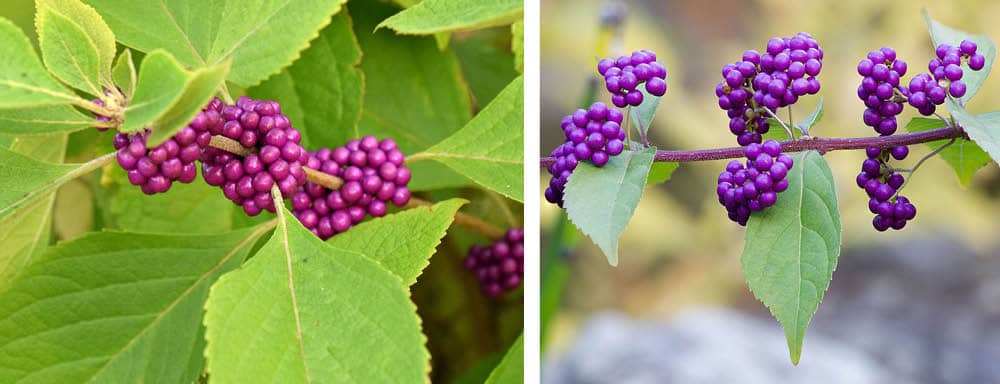Compare the American beautyberry (Callicarpa americana) on the left to an Asian species (C. japonica) on the right. Note how large the leaves are, relative to the berries, and how close the berries grow to the stem of the American species. [Left photo by Ellen Honeycutt, right photo Purple beautyberry, Daisen Park, Sakai, Osaka.” by Laitche is licensed under CC BY-SA 4.0.]
American beautyberry (Callicarpa americana) is a stunning plant in the fall, and I know that many of you agree because it was our member-selected Plant of the Year in 2018. It is a full-sun shrub that is generally deer-resistant and native throughout Georgia. Lately I have seen several people mention that they have American beautyberry, only to show a picture of one of the Asian species (C. japonica from Japan, or C. dichotoma and C. bodinieri from China). This plant was shared with them or even purchased (hopefully not from a nursery) with the designation that it was American beautyberry.
To help ensure that you can recognize the native species, here are 3 characteristics that you can check:
- Size: The American species is a large shrub, ranging from 5-6 feet tall and wide but occasionally reaching even higher under ideal circumstances. Asian species, especially the Chinese ones, are smaller and more compact.
- Leaves: The leaves on C. americana are large and wide while the other species are smaller and noticeably more narrow.
- Fruit: This is the most distinctive difference and it is not the color that matters (all species have white color forms as well as the usual purple), but the arrangement of the fruit (and the flowers before them). A small stem called the peduncle holds the flowers and the fruit on the stem. The American species has a very short peduncle, which means the fruit clusters are very tight. The Asian species have longer peduncles, creating a looser cluster with parts of the stem still visible. Here’s a snippet of the key used to tell the difference showing the primary ways (1) to distinguish American from Asian are the leaf and peduncle sizes. Couplet (2) further distinguishes the two most common Asian species.
1 Leaves 7-23 cm long; peduncles 1-5 mm long …………………………………………………..Callicarpa americana
1 Leaves 2-6.5 cm long; peduncles 10-20 mm long2 Inflorescence supra-axillary, diverging from the twig 1-4 mm above the leaf axil ………C. dichotoma
2 Inflorescence axillary, borne directly in the axil of the leaf ………………………………………..C. japonica
In addition to these visual characteristics, if the plant is sold with a cultivar name, it is more than likely to be non-native as there are many more cultivars of those species. While the birds certainly do like the berries of all species, preserving the genetic value of our native species means it’s worth checking on whether you’re getting the American one or not. There are also small reports of C. dichotoma escaping cultivation into the wild.

